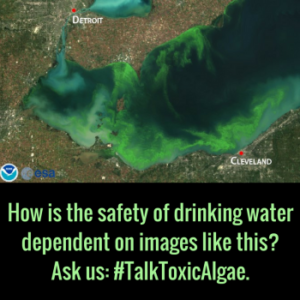Blog
Tagged In: Agriculture, Clean Water, Great Lakes, Lake Erie, Water Pollution
The Trump Administration takes aim at programs that protect our drinking water
Kristy Meyer, July 11, 2017
 The National Oceanic and Atmospheric Administration (NOAA) will release their 2017 Lake Erie forecast tomorrow. Early forecasts predict Lake Erie may see severe growths of toxic algae this summer.
The National Oceanic and Atmospheric Administration (NOAA) will release their 2017 Lake Erie forecast tomorrow. Early forecasts predict Lake Erie may see severe growths of toxic algae this summer.
In 2015, Governor Kasich committed Ohio to a 40% reduction in phosphorus pollution by 2025. Science shows this goal is necessary to prevent toxic algae and foster a healthy Lake Erie. Ohio has a lot of work to do to meet that goal, and the data reflected in the NOAA forecast helps us determine our progress.
Unfortunately, this forecast and other critical Lake Erie resources might disappear. The Trump administration’s proposed federal budget would cut NOAA’s Coastal Science and Assessment funds, which helps generate the forecast, by more than $9.7 million.
This could spell disaster for our water utilities in particular. The NOAA forecast is a crucial source of information for the sport fishing industry and water utilities who treat tainted drinking water. NOAA’s data and satellite imagery allow charter boat captains to find clear water for fishing and drinking water utilities to prepare for possible contamination.
Also on President Trump’s chopping block are programs aimed at helping adoption of conservation best-practices by Ohio’s farmers. A 40% reduction will be impossible without a shift in the way Ohio agriculture applies fertilizers and manure. Studies show that industrial agriculture accounts for 85% of total phosphorus pollution.
These federal budget cuts are dangerous. Information and education are our weapons against the scourge of toxic algae in Lake Erie. They are also urgently important for responding to threats to our drinking water.
Now more than ever, we must band together to save Lake Erie. Here are two easy actions you can take to help:
- Join our #TalkToxicAlgae social media storm today at 11am and help spread the word about this problem.
- Add your name to our petition calling for four common-sense solutions that will help Ohio meet its 40% reduction goal.